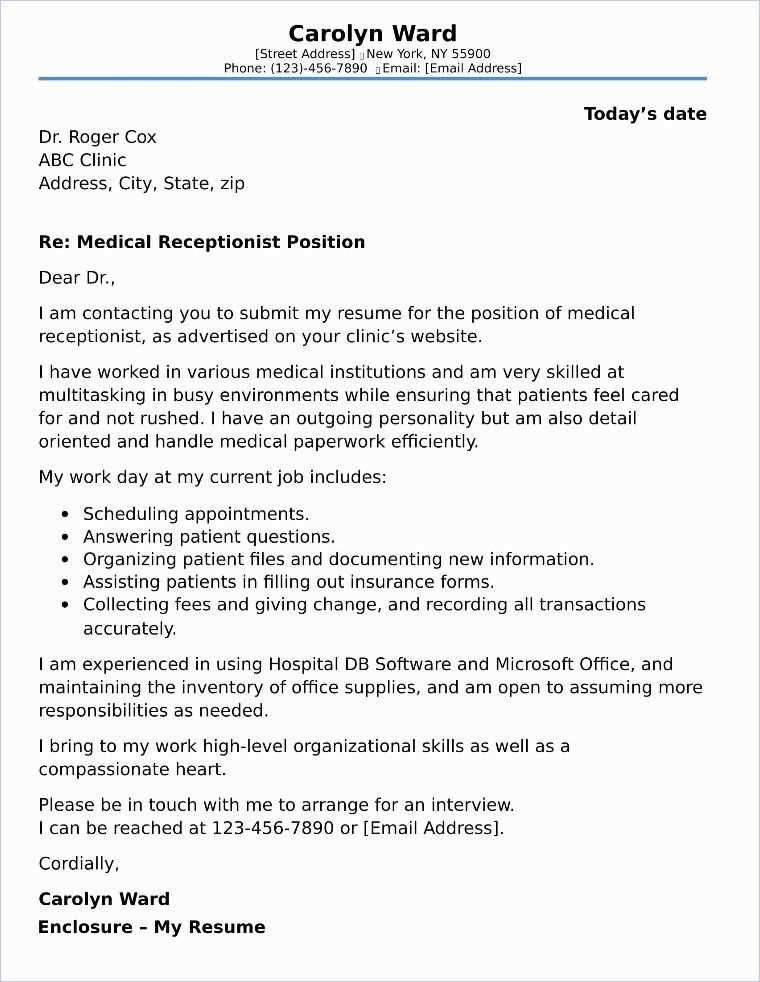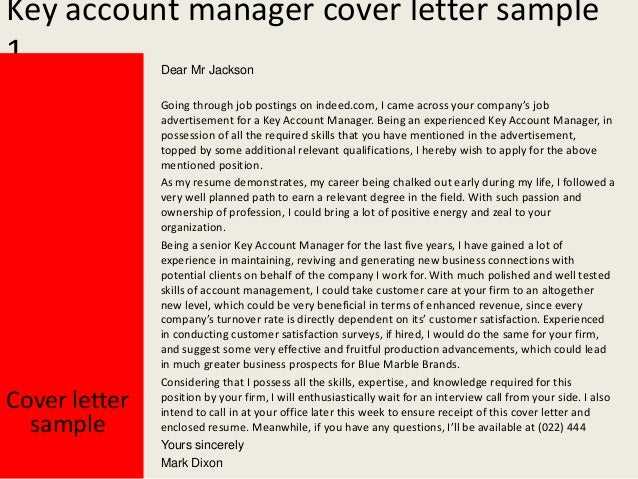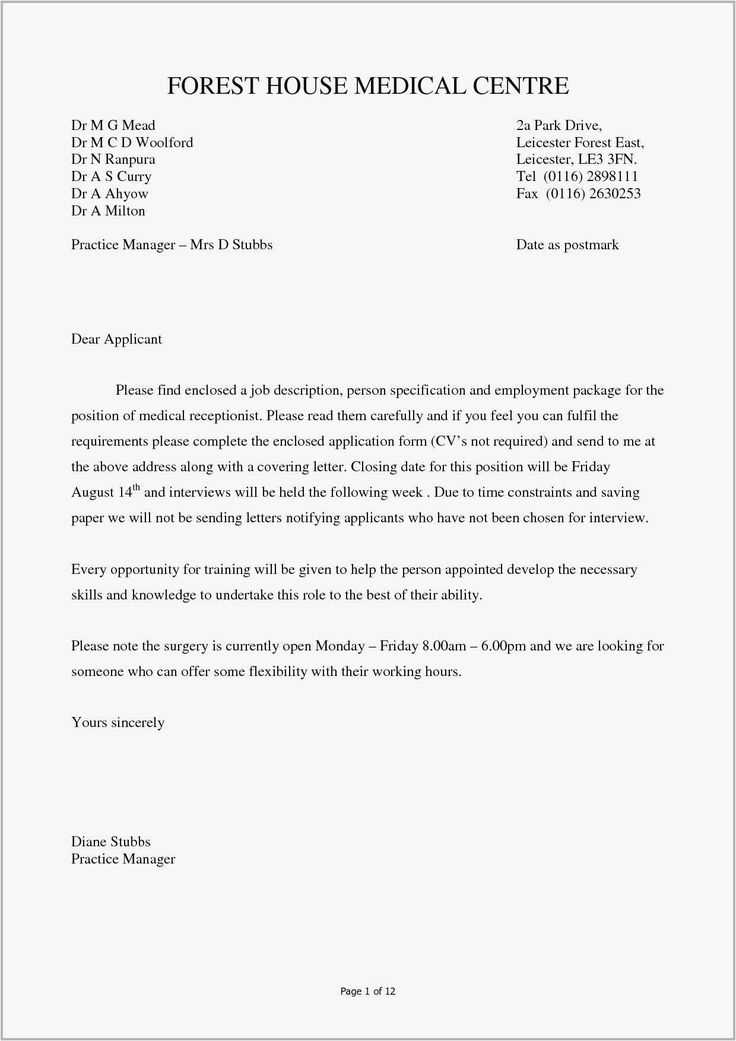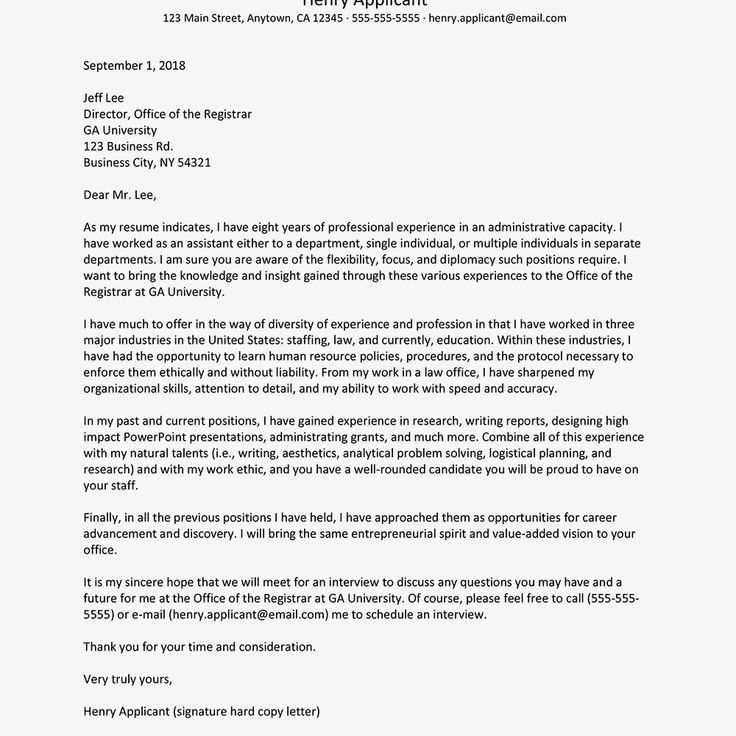Medical receptionist cover letter template

When applying for a medical receptionist position, tailor your cover letter to highlight your skills in managing patient interactions and supporting office operations. Show how your experience with scheduling appointments, handling calls, and maintaining records aligns with the job requirements. Emphasize your organizational abilities and attention to detail as they are crucial in a medical office setting.
In your opening paragraph, directly address the hiring manager by name, if possible. Introduce yourself and briefly explain why you’re the best fit for the role. Mention your previous experience in similar positions, focusing on tasks such as greeting patients, managing appointments, and handling sensitive information. Use strong, action-oriented language to convey your capabilities.
In the following paragraph, describe how your skills and experiences match the specific job duties mentioned in the job listing. Highlight your proficiency with medical software, multitasking abilities, and your understanding of confidentiality protocols. Demonstrate that you are ready to contribute from day one and that you can seamlessly integrate into the existing team.
Conclude your cover letter by reiterating your enthusiasm for the position and expressing your interest in discussing your qualifications further. Be sure to include a polite and professional closing statement, thanking the hiring manager for their time and consideration. Sign off with a call to action, such as scheduling an interview or providing your contact information for follow-up.
Medical Receptionist Cover Letter Template

Begin by directly addressing the hiring manager, mentioning the specific position you’re applying for. Express your enthusiasm for the opportunity and briefly highlight your relevant skills and experience in healthcare settings. Be specific about how your background aligns with the job requirements, ensuring to mention any technical skills, such as appointment scheduling software or medical records management.
Personalize Your Introduction
Personalization is key. Reference the healthcare facility’s name and demonstrate your knowledge of their values or recent developments. For instance, mention how your commitment to providing exceptional patient care aligns with their mission or how you admire their innovative practices. This will help show that you’re genuinely interested in their organization, not just any job.
Demonstrate Your Skills and Experience
In the body of your letter, focus on practical examples that highlight your ability to manage appointments, answer patient queries, and maintain organized medical records. Mention your communication skills and ability to handle high-pressure situations with professionalism. Demonstrate how your experience supports a smooth and welcoming patient experience.
Conclude by expressing your eagerness to discuss how you can contribute to the team. Politely request an interview, emphasizing your availability for further discussion. Be sure to thank them for considering your application.
How to Address the Hiring Manager
Use the hiring manager’s name whenever possible. If the job listing includes a specific contact person, address them directly with “Dear [First Name] [Last Name].” This creates a personal connection right from the start. If you cannot find the name, opt for a general but respectful salutation like “Dear Hiring Manager.” Avoid using outdated terms like “To Whom It May Concern,” as it can feel impersonal.
Ensure the title is correct if you are aware of the person’s position, such as “Dear Dr. [Last Name]” or “Dear Ms. [Last Name].” Using the right title shows attention to detail. If you are unsure about gender or title, it’s acceptable to use their full name, such as “Dear [Full Name].”
Always keep the tone respectful and professional. Tailor your salutation to the level of formality of the company or position, ensuring it matches the company culture. A little research about the company’s communication style can go a long way in determining how to address the hiring manager appropriately.
Key Skills to Highlight in Your Letter
Showcase your ability to manage administrative tasks with precision and attention to detail. Highlight experience with scheduling, answering calls, and maintaining patient records. Demonstrate your proficiency in managing appointment systems and handling patient inquiries smoothly.
Communication and Interpersonal Skills
Strong communication is critical in a receptionist role. Emphasize your ability to interact with patients and medical staff efficiently. Highlight your experience in handling both routine and sensitive conversations with professionalism and empathy.
Organizational and Time Management Skills

Employers seek individuals who can multitask effectively. Mention your ability to prioritize tasks, manage tight schedules, and ensure that all administrative duties are completed in a timely manner without sacrificing quality.
Demonstrating Relevant Experience
Focus on specific tasks you’ve successfully managed in past roles. Highlight your ability to handle patient inquiries, schedule appointments, and maintain organized records. Mention any experience with medical software or office systems that streamlines daily operations.
Use concrete examples to illustrate your skills in multitasking and managing time-sensitive situations. For instance, describe a scenario where you efficiently handled a high volume of calls while ensuring that all patient information was up-to-date and accurate.
Emphasize your communication skills, both with patients and medical staff. Showcase instances where you resolved conflicts or facilitated smooth communication between departments. If you’ve assisted in managing patient flow or coordinated between healthcare providers, highlight those experiences too.
- Handled appointment scheduling and cancellations with minimal disruption.
- Collaborated with medical teams to streamline patient check-in processes.
- Utilized medical records software to ensure data accuracy and efficiency.
- Successfully managed patient concerns, providing clear information and support.
Be clear about the roles you’ve played in administrative tasks such as billing, insurance verification, or patient intake. If you’ve worked with insurance companies or billing departments, this can set you apart from other candidates.
Showcasing Your Knowledge of Medical Terminology

Employers value candidates who demonstrate a solid understanding of medical terms, as it ensures effective communication within a healthcare setting. Mention specific terminology relevant to the job position, such as terms related to anatomy, procedures, or patient care, to highlight your proficiency.
Incorporate examples of how you’ve applied medical terminology in previous roles. For instance, you might explain how you managed patient records or assisted with appointment scheduling by using precise medical language. This reassures employers that you can efficiently handle medical documentation and communication tasks.
Consider including a table in your cover letter to showcase your familiarity with key medical terms. A well-organized list of relevant terms and their definitions can effectively demonstrate your technical knowledge:
| Medical Term | Definition |
|---|---|
| Hypertension | High blood pressure, a common condition affecting the cardiovascular system. |
| Cardiology | The branch of medicine dealing with disorders of the heart. |
| Phlebotomy | The practice of drawing blood for testing or donation. |
| Otolaryngology | The medical specialty concerned with disorders of the ear, nose, and throat. |
By including specific examples and definitions like these, you prove your readiness to engage with medical professionals, patients, and colleagues effectively. Avoid general or overly complicated terms that may confuse rather than clarify your expertise.
Formatting and Final Touches
Ensure your letter is neatly formatted and easy to read. Use a clean, professional font like Arial or Times New Roman, and set the font size to 10-12 pt. Keep the margins at 1 inch on all sides for a well-balanced layout.
Spacing and Alignment
Use single spacing within paragraphs and double spacing between them. Align the text to the left for a consistent, polished look. Avoid full justification as it can create uneven spaces.
Final Proofreading
Check your letter for grammar, punctuation, and spelling errors. Read it out loud to ensure the flow is natural and clear. Pay attention to names, dates, and specific details to avoid mistakes.
Before sending, save the document as a PDF to preserve the formatting and ensure the recipient can open it easily. This step adds a layer of professionalism and prevents any changes to your layout.